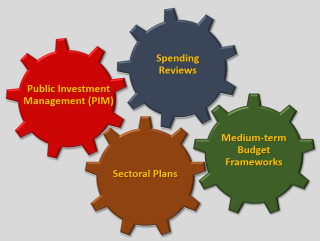
Posted by Vitor Gaspar, David Amaglobeli, Mercedes Garcia-Escribano, Delphine Prady and Mauricio Soto[1]
A recent IMF study finds that delivering on the Sustainable Development Goals (SDGs) requires substantial spending in most countries. The study focuses on health, education and physical capital (roads, electricity, water and sanitation). These are priority investments in people and infrastructure. Low-income developing countries (LIDCs) will need to increase annual additional spending by US$0.5 trillion, by 2030. The annual additional spending being required in emerging market economies (EMEs) adds up to US$2.1 trillion. Relative to the size of their economies, the financing challenge is much larger for LIDCs. For these countries, additional spending is about 15 percent of GDP. In contrast, for EMEs, additional spending corresponds to comparatively modest 4 percent of GDP.
Raising additional revenue by strengthening tax capacity and by better managing public sector assets is an important element of the overall strategy to raise financing for achieving the SDGs. The median tax-to-GDP ratio in LIDCs and EMEs—at 15 percent and 18 percent, respectively—is low when compared with advanced economies where the median tax-to-GDP ratio (excluding social security contributions) stands at 26 percent. Increasing the tax-to-GDP ratio by 5 percentage points of GDP in the next decade is an ambitious but reasonable aspiration in many countries. There is also significant scope for additional revenue from better management of public wealth. For example, revenue gains from nonfinancial public corporations could be as high as 1 percent of GDP a year, which is based on the analysis of returns for a group of advanced and emerging market economies[2]. Additional revenue gains could be achieved from the better management of government financial assets. However, LIDCs have relatively low level of financial assets.
In order to achieve ambitions of 2030, strong national ownership and strong governance frameworks are necessary. It is therefore required to strengthen key aspects of public financial management (PFM), (Figure 1):
Figure 1. Key Elements of PFM for SDGs
Source: Authors.
- Medium-term budget frameworks (MTBF). Achieving the SDGs will require a decade long ramp up in spending, both current and capital, which cannot be credibly and effectively implemented through annual budgets alone. MTBFs provide a natural institutional arrangement for prioritizing, sequencing, planning, and managing revenue and expenditure over a rolling period of three-to-five years. Embedding spending for the SDGs and their financing into MTBFs acts as a disciplining device for executing plans, while improves the understanding of synergies across sectors. It also puts public finance at the service of sustainable, inclusive development.
- Sectoral planning. Line ministries are responsible for developing their respective sectoral plans, which need to be articulated in a national development plan with the SDGs at its core. These plans offer a clear identification of actions, underlying programs and costs. They need to be reflected in the MTBF to obtain a comprehensive and coherent financial framework.
- Public Investment management (PIM). Prior to scaling up spending in key SDG areas, it is critical to strengthen the management of public investment. Whether it is building schools or hospitals, roads or dams, better management of investment spending will generate greater “bang for their buck.” There is a substantial scope for enhancement given that public investment spending efficiency averages only about 60 percent in low income developing and emerging market economy countries (implying that around 40 percent of spending goes to waste). The quality of PIM—which includes legal, institutional, and procedural arrangements—is an important driver of spending efficiency. The Public Investment Management Assessment (PIMA)[3], a tool developed by IMF staff, helps assess the quality of PIM practices in particular in the area of infrastructure investment, and regarding the planning, allocation, and implementing public investment.
- Spending reviews. It is just as important to systematically examine outcomes to assess that existing spending is efficient and effective according to the objectives in the sectoral plans. The spending review process can help redirect expenditures that are considered low priority or ineffective and to identify weaknesses in the PFM that need to be addressed to enhance efficiency. International experience shows that spending reviews that are comprehensive in scope and are undertaken periodically or reviews targeted to specific sectors or programs but carried out annually, are the most effective.
Countries need to spend not only more, but better. Medium Term Budgetary Frameworks, Sectoral Planning, Public Investment Management and Spending Reviews are critical for spending efficiency and effectiveness. Strong and transparent PFM, at the service of inclusive development priorities, plays a crucial role in motivating tax compliance and, thereby, improving tax capacity. It also contributes to sound governance, allowing for synergies with private sector financing and resources from the official donor community. Only a comprehensive and consistent approach, bringing together resource mobilization, spending and PFM, will allow fiscal policy to play its central role in realizing the ambitions of 2030.
[1] Vitor Gaspar is the director of FAD. David Amaglobeli is the assistant to the director in FAD. Mercedes Garcia-Escribano is a deputy division chief in FAD. Delphine Prady is an economist and Mauricio Soto is a senior economist in FAD.
[2] International Monetary Fund, October 2018, “Managing Public Wealth”, Fiscal Monitor.
[3] International Monetary Fund, 2015, “Making Public Investment More Efficient”, Policy Paper.
Note: The posts on the IMF PFM Blog should not be reported as representing the views of the IMF. The views expressed are those of the authors and do not necessarily represent those of the IMF or IMF policy.






